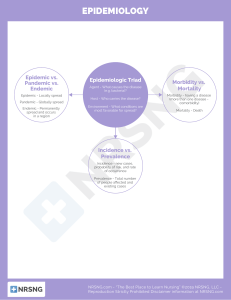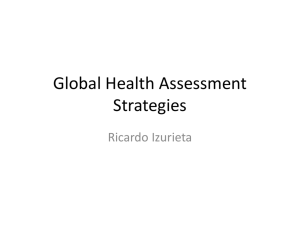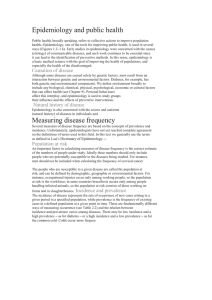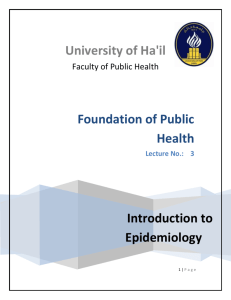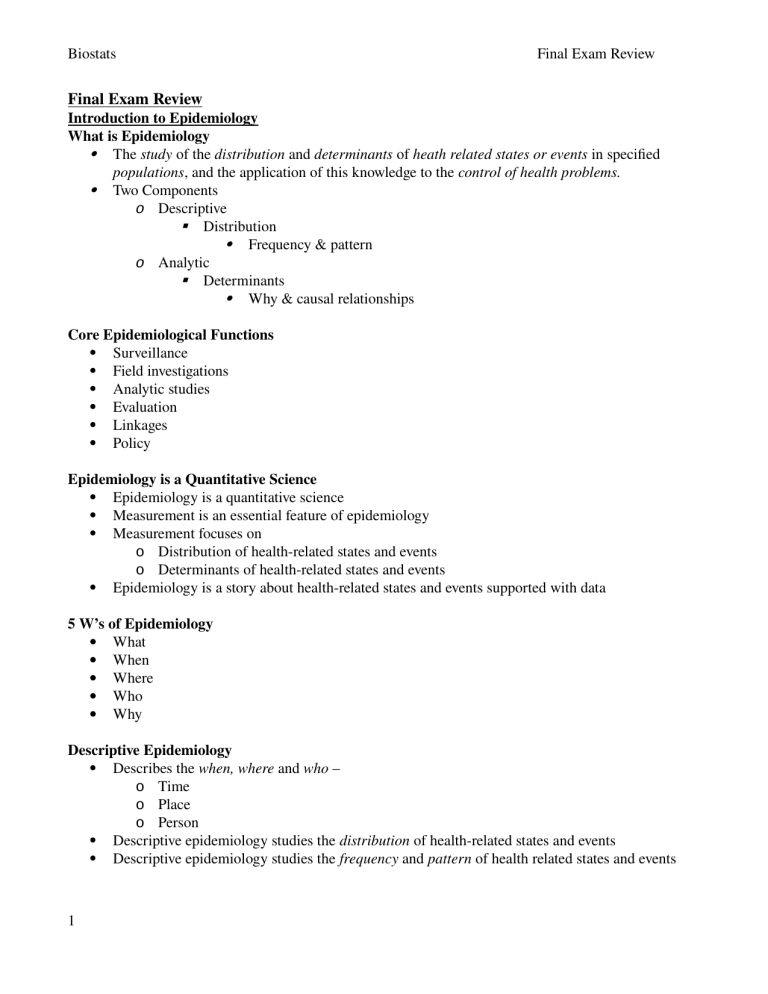
Biostats Final Exam Review Final Exam Review Introduction to Epidemiology What is Epidemiology The study of the distribution and determinants of heath related states or events in specified populations, and the application of this knowledge to the control of health problems. Two Components o Descriptive Distribution Frequency & pattern o Analytic Determinants Why & causal relationships Core Epidemiological Functions Surveillance Field investigations Analytic studies Evaluation Linkages Policy Epidemiology is a Quantitative Science Epidemiology is a quantitative science Measurement is an essential feature of epidemiology Measurement focuses on o Distribution of health-related states and events o Determinants of health-related states and events Epidemiology is a story about health-related states and events supported with data 5 W’s of Epidemiology What When Where Who Why Descriptive Epidemiology Describes the when, where and who – o Time o Place o Person Descriptive epidemiology studies the distribution of health-related states and events Descriptive epidemiology studies the frequency and pattern of health related states and events 1 Biostats Final Exam Review Analytic Epidemiology Why o Cause and effect Quantifies the association between exposures and outcomes to determine causal relationships The ‘why’ examines potential etiologies (helpful or harmful) for the health-related event o The ‘why’ explains the causes of the health-related state or event Analytic epidemiology studies the determinants of health related states and events Descriptive vs. Analytic Epidemiology Descriptive epidemiology describes the o Distribution of health-related events o Frequency and pattern of events o The ‘who, where, and when’ o The ‘person, place, and time’ Analytic epidemiology describes the o Determinants of health-related events o The ‘why’ o The cause(s) The Role of the CDC Nation’s epidemiologist Determinants of Health Determinants of health Basics Biological Environmental Social Health behaviors Biological Sources of Disease Congenital • Infectious • Metabolic • Tumors • 2 Hereditary Inflammatory Nutritional Vascular Biostats Final Exam Review Environmental Sources of Disease Allergens • Chemical exposures Infectious organisms • Nutrition Physical agents • Trauma Social Determinants of Health Health Behavior Determinants of Health Nutrition • Physical activity Rest and relaxation • Tobacco use Alcohol use • Illicit substance use Immunizations Mechanisms of Disease Causation Multicausality Every causal mechanism involves the joint action of a multitude of component causes The etiology of all diseases is multifactorial, even with a simple infectious disease Some disease have very complex etiologies (e.g., cardiovascular disease) The Causal Pie Model Causative agent or event Characteristics of the person Characteristics of the environment Presence of preventative factors Action of catalysts or additive factors Mediating and moderating factors 3 Biostats Interaction between the factors Bradford Hill Criteria for Causation Strength of association Consistency Specificity Temporal relationship Biological gradient Plausibility Coherence Analogy Experimental evidence Models of Disease Causation Etiology of Disease Occurrence of disease can be understood using 3 models: o Epidemiological Triad or Triangle o BEINGS Model o Web of Causation Epidemiological Triad or Triangle BEINGS Model of Disease Causation B - Biological, Behavioral E – Environmental I – Immunological N – Nutritional G – Genetic S – Services, Social, Spiritual Web of Causation 4 Final Exam Review Biostats Final Exam Review Spectrum and Natural History of Disease Spectrum of Disease Describes the severity of disease Can vary from mild to fatal Natural History of Disease Natural history of a disease describes the progression of the disease process over time in an untreated individual Describes the stages of disease o Stage of susceptibility o Stage of preclinical, subclinical, presymptomatic, or latent disease o Stage of clinical disease o Stage of recovery, disability, or death Stage of Susceptibility Pre- exposure Stage of Subclinical Disease Not apparent or asymptomatic Pathological changes occur Pathology may be detected by screening Incubation period for infectious diseases Latency for chronic disease 5 Biostats Final Exam Review Stage of Clinical Disease Onset of symptoms Diagnosis usually occurs during this stage Stage of Recovery, Disability or Death Last stage Levels of Prevention Primary Prevention Used during the stage of susceptibility Protects against the disease o Place the host in good health o Protects against disease or other health-related events (e.g., immunization) o Public health measures Secondary Prevention Used during the preclinical (subclinical, presymptomatic, latent) and early clinical stages of disease Early detection and prompt intervention to control the disease and minimize or eliminate complications Tertiary Prevention Used during the advanced stage of clinical disease or when disability has occurred Measures aimed at reducing the long-term impact of disease and disability Levels of Prevention and the Stages of Disease Stage of susceptibility o Primary prevention Stage of preclinical, subclinical, presymptomatic, or latent disease – o Secondary prevention Stage of clinical disease o Secondary prevention during early part of stage o Tertiary prevention during more advanced disease Stage of recovery, disability, or death o Tertiary prevention Communicable Disease Definition of Communicable Disease The of a disease to o Be transmitted from one person to another OR o To spread through the population is called communicability 6 Biostats Chain of Infection Reservoir Portal of exit Transmission o Direct o Indirect o Airborne Portal of entry Susceptible Host Reservoir Habitat in which the agent grows and lives Reservoirs can be o Human o Animal o Invertebrates (insects, arachnoids) o Environment Portal of Exit Portal of exit from the reservoir o Respiratory tract o Blood o Semen o Other body fluids o Crossing the placenta (mother-to-fetus) o Blood sucking mosquitos Mode of Transmission Direct transmission o Direct contact Ex: kissing, sexual intercourse, soil contact Indirect transmission o Vehicleborne Ex: food, water, bedding, instruments o Vectorborne Ex: mosquitos, fleas, ticks Airborne transmission o Droplet (direct mode of transmission) o Droplet nuclei (indirect mode of transmission) Portal of Entry Portal of entry into the host o Respiratory tract o Mouth o Break in the skin or mucous membrane 7 Final Exam Review Biostats Final Exam Review o Surgical sites o Catheters Susceptible Host Immune status Overall health Nutritional Status Prevention and Control of Infection Primary Prevention for Infection Used during the stage of susceptibility Protects against the disease Includes activities o Eliminate or sanitize the reservoir o Eliminate or cover the portal of exit o Eliminate or cleanse the transmission mode o Cover or filter the portal of entry o Place the host in good health and immunize when available Active and Passive Immunity Active immunity o Body produces its own antibodies in response to having been vaccinated or having a specific disease pathogen invade the body Passive immunity o Administration of immune globulin o Transplacental transfer of immune globulins to the fetus o Transfer of antibodies and other immunoprotectant in human milk Herd Immunity Viewed as the resistance a population has to the invasion and spread of an infectious disease Based on the notion that if a population or group is mostly protected from a disease by immunizations (85% or more), then the chance of a major epidemic occurring is reduced Cocooning Used to protect infants from communicable diseases Only family and friends who are fully immunized are allowed to be around the infant Host-Related Control and Prevention Isolation o Used for persons who are known to be ill with a contagious disease o Used in inpatient settings (hospitals or nursing homes) o State laws as well as accrediting organizations require one or two beds to be designated and as isolation beds Quarantine 8 Biostats Final Exam Review o Used for persons who have been exposed to a contagious disease but may or may not become ill Descriptive Epidemiology Basics of Descriptive Epidemiology Describes the o Frequency of events o Pattern of events Who (person) Where (place) When (time) Using Tables to Describe Person Using a Population Pyramid to Describe Person Using Maps to Describe Place 9 Biostats Final Exam Review Using Event Timelines to Describe Time Health Surveillance Public Health Surveillance Defined as the “ongoing, systematic collection, analysis, and interpretation of health-related data essential to information for the planning, implementation, and of public health practice, closely integrated with the timely dissemination of these data to those responsible for prevention and control” (CDC) Public health surveillance uses data to monitor health problems to facilitate their prevention or control Information gained from surveillance can be used for o Planning disease control and prevention programs o Policy-making Health Indictor Markers of health status o Physical or mental illness o Impairments or disabilities o Social well being o Service provision o Resource availability Notifiable Diseases in the United States Many infectious disease must be reported so that appropriate control measures can be implemented Other diseases are also reported Federal and state mandated reporting Notifiable diseases are those of considerable public health importance because of their seriousness. o Cause serious morbidity or death 10 Biostats o Have the potential to spread o Can be controlled with appropriate intervention Measures of Disease Occurrence Measures of Disease Occurrence Counts o Number (n) o Frequency (f) Ratios Proportions Percentages Rates Ratios Ratios compare two things Divide the numerator by the denominator Expressed as X/Y or X:Y Numerator may or may not be part of the denominator The numerator and denominator may or may not be related Proportions (p) Numerator is always a part of the denominator A Calculated as p= A+B Usually calculated as a decimal Ex. 1/8 = 0.125 Percentages (P) Numerator is always a part of the denominator Just a proportion multiplied by 100!!! e.g., 1/8 =.125 = 12.5% A x 100 Calculated as P= A+B Rates Frequency of an event in a population in a specified period of time Population is always specified Time period is always specified Vital Statistics Vital Statistics Three major categories of vital statistics o Mortality o Morbidity o Natality Mortality 11 Final Exam Review Biostats Final Exam Review Mortality rate is a measure of the frequency of occurrence of death in a defined population during a specified interval. (CDC, 2006) n∗¿ deaths during a givrn time period x 10 ¿ the population∈ whichthe deaths occurred ¿ Crude (All Cause) Mortality Rate The crude mortality rate is the mortality rate from all causes of death for a population Also called the “All Cause” Mortality Rate Example – o In 2003, there were 2,419,921 deaths in the USA o The estimated population was 290,809,777 o The crude mortality rate was 2,419,921 ⁄ 290,809,777 × 100,000 = 832.1 deaths per 100,000 population Infant Mortality Rate Infant mortality rate o Deaths of infants < 1 year of age o Denominator is number of live births in the given time period o Live birth has a specific definition o Per 1,000 live births Single most widely used health indicator to compare nations Neonatal Mortality Rate Neonatal mortality rate o Deaths of infants < 28 days of age o Denominator is number of live births in the given time period o Per 1,000 live births Maternal Mortality Rate Maternal mortality rate o Deaths of women due to pregnancy related causes during pregnancy or during the first 42 days after pregnancy termination, regardless of the duration of the pregnancy o Denominator is number of live births in the given time period o Per 100,000 live births Morbidity A morbidity rate is a measure of the frequency of occurrence of disease or injury in a defined population during a specified interval. Cases during a giventime period x 10 n∗¿ ¿ the population∈which the cases ocurred Incidence and Prevalence Incidence and prevalence are the two major measures of disease frequency Prevalence 12 Biostats Final Exam Review Prevalence refers to the status of disease, not the onset Prevalence measures the frequency of a disease at a particular point in time Prevalence measures all cases (old and new) at a specified period of time Prevalence is calculated as a proportion Number of individuals who have a disease at a particular point ∈time Prevalence = Total population at risk at the specified time Point prevalence = assessed at one specific point in time Period prevalence = assessed during a certain period Incidence Incidence measures the rate at which people without a disease develop the disease during a specified period Incidence is a measure of the onset of disease Incidence measures the appearance of disease Incidence means new Incidence Proportion Incidence Proportion = Also called o Risk o Attack rate o Probability of developing a disease Incidence Rate number of new casesof a disease∈a specified time period time that each person was observedd , totaled for all persons Also known as “Person-Time Rate” Most accurate estimate of risk More difficult to calculate Accounts for incomplete data Incidence Rate = Epidemiologic Study Designs Levels of Evidence 13 number of New cases of a disease∈a specified time period population at risk of the disease at the start of that time period Biostats Final Exam Review systemic reviews randomized controlled trails nonradomized trials cohort studies case-control studies cross-sectional studies case reports and case series opnion, experience, and theory Systemic Reviews: Meta- Analyses Study of studies Method used in Cochrane Reviews and AHRQ Reviews Very powerful methodology Stringent criteria for inclusion in the analysis Quantitative analysis to combine and compare results of the studies Study Designs in Epidemiology Experimental studies o Randomized trials o Non-randomized trials (quasi-experiments) Observational studies o Cohort studies o Case-control studies o Cross- sectional studies Prospective o Randomized controlled trails o Quasi-experiments (non-randomized trials) o Prospective cohort studies Retrospective o Retrospective cohort studies o Case-control studies Cross-sectional Prospective Study Designs Randomized Clinical Trials o Randomization to treatment groups o Control of the intervention Non-randomized clinical trials (quasi-experiments) o No randomization to treatment groups 14 Biostats Final Exam Review o Comparison group may be different from the intervention group o Control of the intervention Prospective Cohort Studies A group (cohort) of disease-free individuals is identified at one point in time and then followed over a period of time to determine whether whether the outcome (disease) occurs Retrospective Cohort Studies Retrospective study that have a historical perspective o Requires access to information about the subjects before the exposure to disease causing factors and the onset of disease occurs o Often able to accomplish this when there are comprehensive medical records Also known as historical cohort studies Case-Control Studies Retrospective study design Studies people who already have the disease and looks backward at exposures Two groups of individuals are studied o A group that has the disease under study (cases) o A group that does not have the disease under study (controls) Their health information is then examined to determine whether there are risk factors that may be related to their current disease Cross-Sectional Studies A population is studied at a single point in time Participants are asked about their current disease state and their exposures to certain factors Also known as prevalence studies Weakest study design Risk: What Is It? Calculation of Risk The probability that an event will occur Risk is calculated as a proportion Risk is the same as the incidence proportion • Risk is presented as a probability and can vary from 0 to 1.0 number of people who get the disease during a desginated period Risk= population of interest at the start of teh designated time period Absolute and Attributable Risk Absolute Risk o The overall incidence of the disease in a specified population o Calculated the same as the incidence proportion Attributable Risk o The amount of disease associated with a causative factor in a specified population 15 Biostats Final Exam Review Measure of Association Measures of association are used to compare the occurrence of disease in one group with the occurrence of disease in another group Commonly used measures are o Risk Ratio or Relative Risk (RR) o Odds Ratio (OR) Relative Risk (RR) Relative Risk is a measure of association between the exposure to a particular factor and the risk of a particular disease or outcome Can only be calculated from prospective studies incidence rate among the exposed Relative Risk ¿ incidence rate amongthe non−exposed Odds Ratio (OR) Is used to estimate the Relative Risk when the RR cannot be calculated Used in case-control and other retrospective studies the odds that a case was exposed Odds Ratio ¿ the odds taht a control was exposed Interpretation of the Risk and Odds Ratios RR or OR = 1 o Risk/Odds in the exposed is equal to the risk/odds in the non-exposed group RR of OR > 1 o Risk/Odds in the exposed group is greater than the risk/odds in the non-exposed group RR or OR < 1 o Risk or Odds in the exposed group is less than the risk/odds in the non-exposed group Risk Ratios: Confidence Intervals Risk ratios and odds ration are estimates are the actual population risk and odds ratios Confidence intervals are calculated for risk and odds ratios If the confidence interval includes 1, the risk ratio is not statistically significant and that means the exposure did not significantly increased or decreased the risk of disease If the confidence interval does not include 1, the risk ratio is statistically significant and that means the exposure significantly increased or decreased the risk of disease Confidence Intervals If the CI includes 1, there is not a difference between the exposed and unexposed groups o RR or OR = 1.5 [CI: 0.8, 2.2] If the CI does not include 1, there is a difference between the groups o RR or OR = 1.5 [CI: 1.1, 1.9] If there is a difference between the groups, you have to determine whether the difference is increased or decreased 16 Biostats Final Exam Review The exposure group (RR) or the cases (OR) are always in the numerator and the comparison (non-exposed or control) groups are always in the denominator If the RR or OR is greater than 1 and the CI does not include 1, that means there is a greater risk in the exposed group RR or OR = 3.3 [CI: 2.0, 4.6] If the RR or OR is less than 1 and the CI does not include 1, that means there is a reduced risk in the exposed group OR = 0.72 [CI : ).54, 0.92] Health Screening Basics Screening is used to promote detection of diseases in their earliest stages, when treatment has the greatest chance of working, in order to reduce morbidity and mortality Screening as Secondary Prevention Health screening activities are used to identify disease during the preclinical (subclinical, presymptomatic, latent) stage of disease Stage of Subclinical Disease Not apparent or asymptomatic Pathological changes occur and some can be detected by screening Incubation period for infectious diseases Latency for chronic disease Characteristics of Screening Tests Sensitivity Probability that a person with the disease will test positive for the disease (true positive) The ability of the test to correctly identify those with the disease Probability of correctly identifying the disease Specificity Probability that a person who does not have the disease will test negative for the disease (true negative) The ability of the test to correctly identify those without the disease 17 Biostats Final Exam Review Positive Predictive Value Probability that a person who has a positive test actually has the disease Proportion of people with a positive test result who have the disease Negative Predictive Value Probability that a person who has a negative test does not have the disease Proportion of people with a negative test result who do not have the disease Investigation of an Outbreak Terminology Cases o Case An individual who has the disease, disorder, injury, health behavior, or health event of interest o Primary Case First case of the disease or condition or behavior o Index Case 18 Biostats Final Exam Review First brought to the epidemiologists attention Not necessarily the primary case o Secondary Case Cases that became ill after the disease was introduced into the population and become infected from the primary case o Suspect Case An individual who has all of the signs and symptoms of a disease or condition, yet not diagnosed o Confirmed All criteria are met Endemic o Amount of disease usually present in a community Hyperendemic o Persistent high levels of disease Sporadic o Occurs infrequently and irregularly Epidemic o An increase in the number of cases above what is expected in the population in that area Outbreak o An epidemic but in a limited geographic area Pandemic o Epidemic that has spread over several countries or continents Spreads of Epidemics Common source o Attributed to a specific source Point sources Intermittent sources Continuous sources Propagated o Transmitted from person to person Mixed epidemic o Starts with a common source o Then spread by person-to-person contact Steps in an Investigation Steps in a Field Investigation 1. Establish the existence of an epidemic (or outbreak) 2. Confirm the diagnosis 3. Establish criteria for case identification 4. Search for missing cases 5. Count cases 6. Orient the data according to person, place, and time 7. Classify the epidemic 8. Determine who is at risk of becoming a case 9. Analyze the data 10. Formulate a hypotheses 19 Biostats Final Exam Review 11. Test hypotheses 12. Develop reports and inform those who need to know 13. Execute control and prevention measures 14. Administration and planning activities Establish Criteria for Case Identification Standard clinical criteria (what) Loose case definition vs. strict case definition A case may be further characterized by o Who o Where o When Case Definitions Count Cases Use standard descriptive statistics Exposure status and disease frequency need to be determined and compared with the appropriate at-risk population Examine the Data by Person, Place and Time Person o Inherent characteristics (age, race/ethnicity, sex) o Acquired characteristics (immunity or marital status) o Activities (occupation, leisure, use of medications) 20 Biostats o Conditions (socioeconomic state, access to health care) Place o Residence o Birthplace o Place of employment o School district, hospital unit o Country o State o County o Census tract o Street address o Map coordinates Time o Epidemic curve Classify the Epidemic Use an epidemic curve to classify the epidemic o Common source o Propagated o Mixed Analyze the Data Descriptive analysis o Descriptive statistics Graphic display o Spot Map o Epidemic Curve Testing for relationships o Associations o Correlations Implement Control and Prevention Measures Immunization programs Risk factor prevention Behavior change programs 21 Final Exam Review
